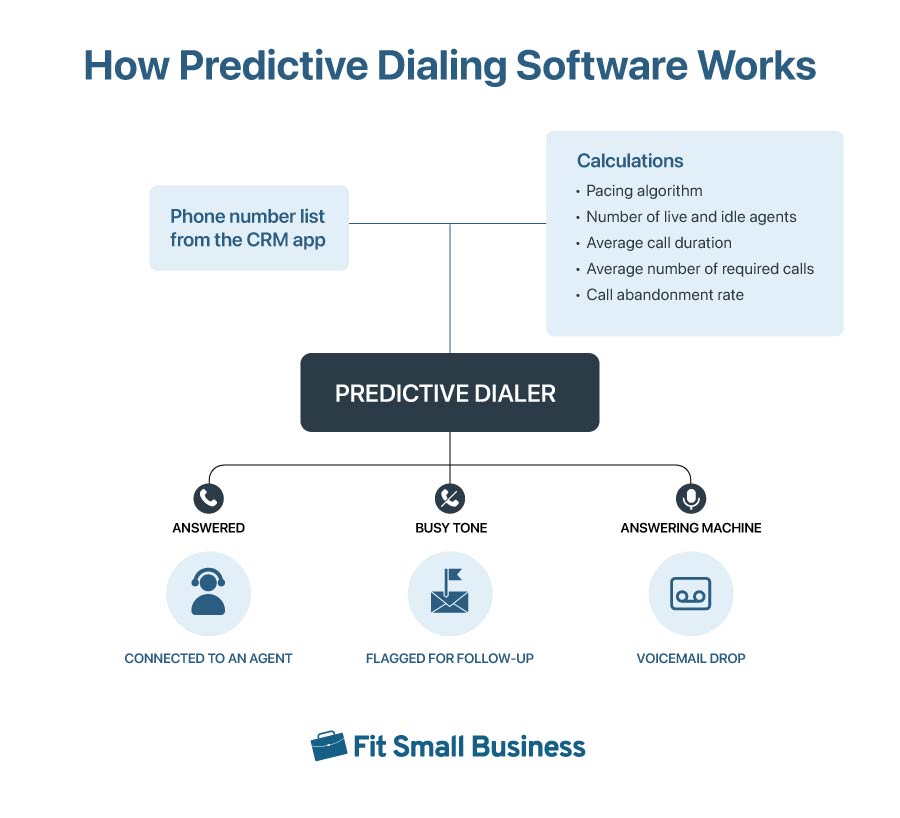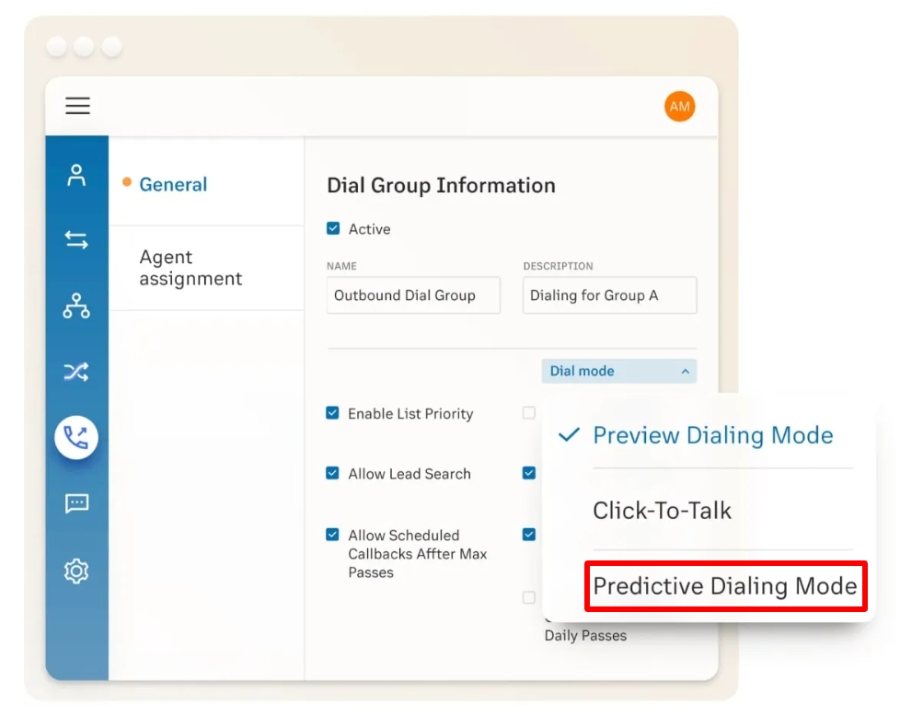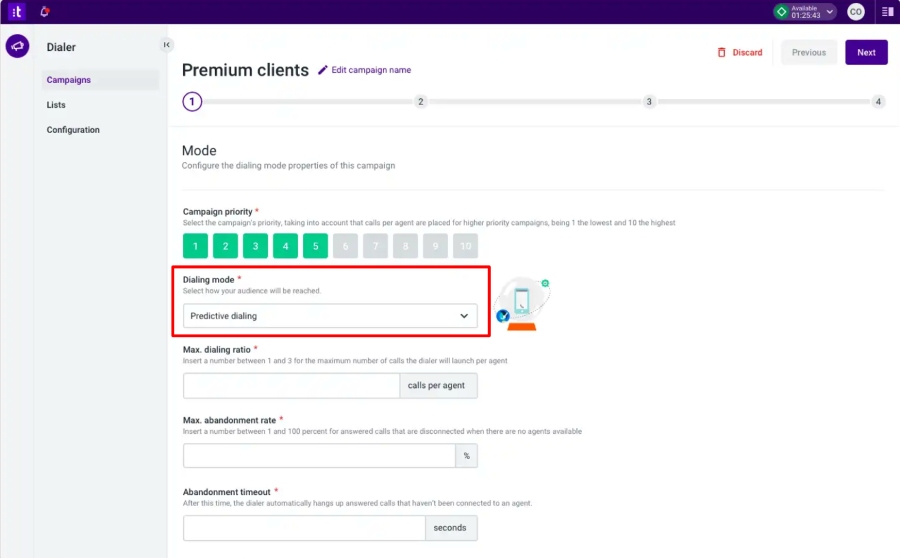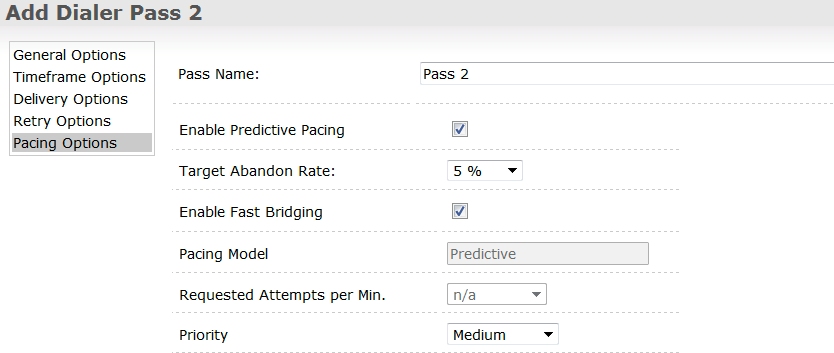A predictive dialer software app is a solution that uses artificial intelligence (AI) and machine learning (ML) to predict agent availability and adjust dialing rates in real time. It calculates the average call length and places multiple calls just before a representative ends a call. Statistical algorithms estimate the average number of calls it takes before a human picks up, giving you an idea of how many numbers to dial. Learn more about what is predictive dialing and its benefits.
How Predictive Dialing Software Works
Predictive dialer software solutions work with a contact database or a customer relationship management (CRM) platform, which automatically compiles the numbers to call. The dialer computes the average length of a phone call for each agent and the average number of dials to establish a connection, adjusting the dialing rate based on those calculations. In other words, it forecasts the agent’s availability to connect answered calls right away.
When the system’s predictions are accurate, customers are less likely to hang up because they are able to speak to an agent almost instantly, and service representatives don’t spend too much idle time. If a call goes unanswered, the predictive dialer software dials the next number in its list.
The system places a call to several phone numbers simultaneously, distributing answered calls to various agents. Thus, it helps the call center team become more efficient in its customer outreach efforts. In summary, the accuracy and speed of your predictive dialer depend on several factors, including:
- Pacing algorithm: This is the formula that takes into account the number of agents available to take a call and the number of outgoing calls to be made. To put it simply, if there are several agents free to take a call, the dialing pace increases with more numbers dialed, and if there are fewer representatives available, the pace slows down with fewer numbers dialed.
- Number of live and idle agents: The dialing software uses information about your available agents, including the workforce schedule and the agents’ statuses.
- Average call duration: Predictive dialers estimate the typical length of your phone calls. It uses ML to adjust the expected conversation duration for various campaigns. For instance, follow-up campaigns may take less time per call than final sales calls.
- Average number of required dials: Predictive dialing software assesses the response rate of your contact list and determines how many numbers it needs to dial to get a caller on the line.
- Call abandonment rate: Contact center analytics track how many calls result in hang-ups, known as call abandonment. Predictive dialing software adjusts the formula to ensure agents answer the line immediately.

Benefits of a Predictive Dialer
To better appreciate what a predictive dialer is, you must learn how it benefits business operations. In a nutshell, this type of autodialer is efficient and flexible, lowering operating costs by increasing productivity and providing campaign and agent performance details. In addition, advanced voice-over-internet-protocol (VoIP) features like speech sentiment and live-reporting dashboards offer coaching opportunities and insights in real time.
The benefits of predictive dialing systems include:
- Generating more leads at scale: Industry-leading platforms scale up to handle a higher number of outbound calls. It lets you quickly add or remove agents from campaigns and support multiple initiatives that teams are able to switch seamlessly between them.
- Reducing unproductive dialing time: Busy signals, disconnected lines, and unanswered calls result in downtime. Predictive dialers use call progress analysis (CPA) and voicemail detection to connect agents only to live calls. Also, manual dialing that doesn’t have click-to-call takes extra time for agents to manage. Predictive dialing software eliminates this tedious task, allowing your staff to focus on talking to live callers.
- Enabling your team to prioritize follow-ups: Predictive dialers flag unsuccessful calls and update lists highlighting leads or customers to call back. After several unsuccessful attempts, the number can be lowered in calling priority or bumped from the calling list completely.
- Lowering agent idle time: Predictive dialing platforms keep a steady stream of calls going to your agents. It monitors agent idle time between calls and adjusts the algorithm to keep your team busy.
- Supporting compliance obligations: Predictive dialing software as part of a contact center platform automatically verifies numbers against updated blocked numbers in your business’ do not call (DND) database and people on the National DNC Registry.
Top Predictive Dialer Software at a Glance
Call center systems with predictive dialing systems come with various capabilities and pricing points. Most solutions offer other types of outbound dialers, such as power, progressive, and preview modes. Others have workforce management and engagement tools. Most providers offer entry-level plans priced at $70 to $100 per user. Still, there are some with custom pricing, requiring businesses to reach out directly to the vendor.
Here are some of the best predictive dialer software worth adopting in your business communications:
Key Features of a Predictive Dialer
Predictive dialing systems are essentially call center platforms that automate the process of placing outbound calls. They are equipped with capabilities that further support improved efficiency in call campaigns. When choosing among VoIP phone systems, consider the following important features:
- CRM integration: This lets you see customer profiles while on a call, trace previous customer interactions, and get a full context of customer requests or queries, making the resolution of concerns more efficient. Before settling on a particular platform, see if your customer relationship management (CRM) app is included in the provider’s integrations catalog.
- DNC management: This feature lets you comply with DNC rules and ensures you won’t be penalized with hefty fines.
- Customized dial time: Predictive dialers sort through the list of numbers based on their time zones and area codes. This avoids contacting customers at inappropriate times.
- Call monitoring: This allows managers to observe live calls and provide real-time guidance to agents. Call monitoring tools include listen, barge, and takeover.
- Voicemail drop: When predictive dialers detect answering machines, they send prerecorded messages to a contact’s voicemail.
- Reporting and analytics: Know the status of communication campaigns and measure the performance of customer service representatives. Call center platforms display the total number of connected calls, waiting in queue, missed calls, and graphs of call volumes for different times of the day and days of the week. These pieces of information should help you adjust strategies for tackling outbound calling campaigns.
Who Predictive Dialers Are Ideal For
In a nutshell, companies with large outbound call volumes benefit the most from predictive autodialers. The size of the call campaigns generates enough statistical data to make the algorithm more accurate. Moreover, call center systems with autodialers are usually equipped with other tools like quality assurance and workforce management, which are valuable in supervising several customer service teams handling multiple calls.
But aside from companies with high call volumes, the best predictive dialer software solutions are ideal for specific industries, including the following:
Industries | Predictive Dialer Applications |
|---|---|
Banking & Finance |
|
Credit Card & Loan Collection |
|
Telemarketing & Sales |
|
Job Recruitment |
|
Healthcare |
|
Who Predictive Dialers May Not Work For
While predictive dialers present various benefits, like scaling lead generation and reducing agent idle time, they are not general tools for all types of businesses. For one, since it uses mathematical algorithms, it requires volumes of data to achieve accuracy. Small businesses handling less than 100 calls a day may not find predictive dialers worth it. Moreover, the cost of these platforms is too high for managing low call volumes.
Aside from small teams, predictive dialing systems may not work for these types of businesses:
- Businesses with non-tech-savvy team members: The outbound dialing system is complex, and navigating it involves a slight learning curve. Extensive training is necessary to maximize its benefits. If you’re looking to launch customer outreach efforts quickly, the downtime may not align with your goals.
- Organizations that sell expensive goods and services: These calls require agents with technical knowledge and expertise, and usually last longer than typical customer service calls. It will be difficult for autodialers to make accurate predictions on varying lengths of calls.
- Companies making cold calls: State and federal regulations often require consent from your contact before using an automated system for communications. These will generally be warm leads who have agreed to have correspondence from your company.
Alternatives to Predictive Dialing Systems
There are several ways to reach many people at once, and, in some cases, other communication channels may be more fruitful. This is especially true if your contacts don’t pick up the phone or prefer alternative communication methods. The following solutions can be more affordable for smaller teams:
According to EZ Texting’s 2022 Consumer Texting Behavior Report, the majority of consumers read (65%) and respond (55%) to new text messages within five minutes. Sixty-four percent claimed that they feel curious when receiving a new text message, a positive sentiment for businesses using the communication channel for informing their audience. Leverage this platform by using text messaging services that let you send dozens or hundreds of messages to customers and leads.
The latest Statista report shows that as of January 2023, there are about 2 billion WhatsApp users, and over 1 billion WeChat users. Facebook Messenger has around 930 million users worldwide. More consumers use instant messaging to reach out to businesses and vice versa, primarily because of real-time and personalized communication.
Most contact center systems like RingCentral Contact Center allow companies to manage chat communications on the platform, on top of the voice calls. If you want to keep all customer interactions within one system to avoid overlooking important messages, consider contact center systems.
According to a survey conducted by UpCity, more than half of email marketers polled hit an average return on investment (ROI) of $21 to $40 for every dollar spent on email marketing campaigns. The strategy is less time-consuming than phone calls because your team is able to send the message to many people at once and add contacts to automated email sequences. Mailchimp and HubSpot are two popular software options for email marketing.
Frequently Asked Questions (FAQs)
No, predictive dialers are not illegal. However, they should comply with TCPA regulations, which protect consumers from harassing telemarketing calls. The federal statute prohibits automated dialing and leaving prerecorded messages without the customer’s consent. Similarly, it gives consumers the option to revoke consent in receiving calls and messages.
Predictive dialers place multiple calls simultaneously, using machine learning to match the dialing rate and agent availability. Progressive dialers dial one number at a time and connect answered calls to agents who are free to take the call. To know more about autodialers, check out our comprehensive guide on outbound dialers.
No, an autodialer is a call center phone feature that automates the placing of outbound calls. A spyware dialer, on the other hand, is a malicious program installed on a computer that dials premium phone numbers to increase usage costs. Familiarize yourself with VoIP security threats and the best practices to protect your business.
Bottom Line
Predictive dialers boost call center productivity by connecting agents to live callers quickly. The software uses mathematical formulas to predict average call durations and automatically adapt the pace of outreach. Many top-rated business phone systems offer outbound dialers on upper-tier plans. Likewise, contact center software provides dialers for blended call centers.
Consider a provider like RingCentral for your predictive dialing needs. It has business and omnichannel contact center solutions. Both options help optimize your outreach efforts while improving agent and customer experiences.


